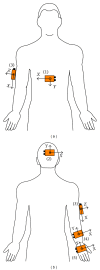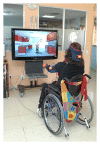Kinematic metrics based on the virtual reality system Toyra as an assessment of the upper limb rehabilitation in people with spinal cord injury
- PMID: 24895627
- PMCID: PMC4017839
- DOI: 10.1155/2014/904985
Kinematic metrics based on the virtual reality system Toyra as an assessment of the upper limb rehabilitation in people with spinal cord injury
Abstract
The aim of this study was to develop new strategies based on virtual reality that can provide additional information to clinicians for the rehabilitation assessment. Virtual reality system Toyra has been used to record kinematic information of 15 patients with cervical spinal cord injury (SCI) while performing evaluation sessions using the mentioned system. Positive correlation, with a moderate and very strong association, has been found between clinical scales and kinematic data, considering only the subscales more closely related to the upper limb function. A set of metrics was defined combining these kinematic data to obtain parameters of reaching amplitude, joint amplitude, agility, accuracy, and repeatability during the evaluation sessions of the virtual reality system Toyra. Strong and moderate correlations have been also found between the metrics reaching and joint amplitude and the clinical scales.
Figures








Similar articles
-
[Effectiveness of the virtual reality in the rehabilitation of the upper limb in the spinal cord injury. A systematic review].Rev Neurol. 2019 Aug 16;69(4):135-144. doi: 10.33588/rn.6904.2019034. Rev Neurol. 2019. PMID: 31334556 Spanish.
-
Effectiveness of the Virtual Reality System Toyra on Upper Limb Function in People with Tetraplegia: A Pilot Randomized Clinical Trial.Biomed Res Int. 2016;2016:6397828. doi: 10.1155/2016/6397828. Epub 2016 Jan 18. Biomed Res Int. 2016. PMID: 26885511 Free PMC article. Clinical Trial.
-
Upper limb posture estimation in robotic and virtual reality-based rehabilitation.Biomed Res Int. 2014;2014:821908. doi: 10.1155/2014/821908. Epub 2014 Jul 8. Biomed Res Int. 2014. PMID: 25110698 Free PMC article.
-
Upper limb rehabilitation after spinal cord injury: a treatment based on a data glove and an immersive virtual reality environment.Disabil Rehabil Assist Technol. 2016 Aug;11(6):462-7. doi: 10.3109/17483107.2015.1027293. Epub 2015 Jul 16. Disabil Rehabil Assist Technol. 2016. PMID: 26181226 Clinical Trial.
-
Robot-assisted Therapy for the Upper Limb after Cervical Spinal Cord Injury.Phys Med Rehabil Clin N Am. 2019 May;30(2):367-384. doi: 10.1016/j.pmr.2018.12.008. Epub 2019 Mar 2. Phys Med Rehabil Clin N Am. 2019. PMID: 30954153
Cited by
-
Predicting task performance from upper extremity impairment measures after cervical spinal cord injury.Spinal Cord. 2016 Dec;54(12):1145-1151. doi: 10.1038/sc.2016.77. Epub 2016 May 31. Spinal Cord. 2016. PMID: 27241449
-
[Driving improvement in spinal cord injury patients using virtual reality. Systematic review].Rev Neurol. 2022 Jul 16;75(2):31-40. doi: 10.33588/rn.7502.2022091. Rev Neurol. 2022. PMID: 35822569 Free PMC article. Spanish.
-
Cardiac autonomic modulation in response to postural transition during a virtual reality task in individuals with spinal cord injury: A cross-sectional study.PLoS One. 2023 Apr 13;18(4):e0283820. doi: 10.1371/journal.pone.0283820. eCollection 2023. PLoS One. 2023. PMID: 37053177 Free PMC article.
-
Virtual Reality as a Therapeutic Tool in Spinal Cord Injury Rehabilitation: A Comprehensive Evaluation and Systematic Review.J Clin Med. 2024 Sep 13;13(18):5429. doi: 10.3390/jcm13185429. J Clin Med. 2024. PMID: 39336916 Free PMC article. Review.
-
Efficacy of Virtual Reality Rehabilitation after Spinal Cord Injury: A Systematic Review.Biomed Res Int. 2019 Nov 13;2019:7106951. doi: 10.1155/2019/7106951. eCollection 2019. Biomed Res Int. 2019. PMID: 31828120 Free PMC article.
References
-
- Wyndaele M, Wyndaele J-J. Incidence, prevalence and epidemiology of spinal cord injury: what learns a worldwide literature survey? Spinal Cord. 2006;44(9):523–529. - PubMed
-
- Harvey LA, Batty J, Jones R, Crosbie J. Hand function of C6 and C7 tetraplegics 1–16 years following injury. Spinal Cord. 2001;39(1):37–43. - PubMed
-
- Snoek GJ, Ijzerman MJ, Hermens HJ, Maxwell D, Biering-Sorensen F. Survey of the needs of patients with spinal cord injury: impact and priority for improvement in hand function in tetraplegics. Spinal Cord. 2004;42(9):526–532. - PubMed
-
- Eng K, Siekierka E, Pyk P, et al. Interactive visuo-motor therapy system for stroke rehabilitation. Medical and Biological Engineering and Computing. 2007;45(9):901–907. - PubMed
Publication types
MeSH terms
LinkOut - more resources
Full Text Sources
Other Literature Sources
Medical

